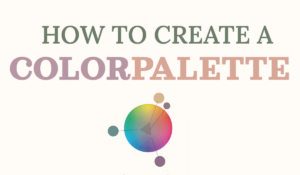When talking about which hue comes from mixing blues and reds, some speak of violet and some speak of purple. But, is there a difference? Or are they the same thing? I, for once and for all figured it out so you don’t have to. Keep reading to find out the important difference between violet and purple!
The important difference between violet and purple
Here’s an example of the two hues we are talking about:

The difference between violet and purple
As we can see in the image above, violet leans more towards blue, and purple leans more towards red. We know this by imagining where each hue lies on the color wheel and then decide whether it’s a cool or warm color. But, there’s another important difference between violet and purple.
Violet exists, purple is a perception
Last time we talked about how we see things because of light, which makes use of additive color theory. In short: different mixtures of the primaries used for light (red, green, and blue), create every other color of light. We visualise this on what is called the visible spectrum of light.

Turns out, violet is part of the visible light spectrum but purple is not. This means that when we see violet, we actually see violet. But when we see purple, we see red and blue at the same time. Our eyes and brains perceive it as purple, but it’s not part of the visible light spectrum.
Violet and purple on the color wheel

When it comes to mixing colors, purple exists out of equal amounts of blue and red. Violet, however, exists out of blue, and a lot lesser amount of red. If we place these colors on the color wheel purple sits right between red and blue, and violet sits between purple and blue. Since purple leans toward the general warm colors it is considered a warm hue. Violet leans towards the cool colors so it is considered a cool hue.
Why people misinterpret violet for purple and vice versa
Like when misnaming cyan and magenta for blue and red, people misinterpret purple for violet as a force of habit. They usually stick to one word and go with it. While it isn’t a huge deal if people do this, it can lead to confusing situations and it’s technically incorrect. Good thing you can now teach them the difference :)
How to mix a perfect purple and violet color
To avoid muddiness, we need to mix colors of the same temperature. We need to mix cool blues with cool yellows to create vibrant greens since greens are considered cool colors. We need to mix warm reds with warm yellows to create warm vibrant oranges since oranges are considered warm colors. When it comes to purple and violet though, it is different.
Let’s try all possible combinations and see what we get:

First I mixed a cool blue (cyan) with a warm red. The mixture in the middle which is purple comes out very dull. Violet, which leans more towards the blue looks very dull as well.
On the top right, I mixed a warm blue with a warm red. The outcome is very similar to the previous colors, but they are slightly less dull.
On the bottom left I mixed a cool blue (cyan) with a cool red (magenta). The outcome is a lot brighter than the previous colors!
Lastly, on the bottom right, I mixed a warm blue with a cool red (magenta). The outcome looks very similar to the previous colors.
If you like to learn more about color theory click here!
Which combination results in the brightest colors?
Let’s see if what we see is actually true. I sampled the colors and looked at the saturation percentage. 100% saturation means the color is at its full vividness. 0% saturation means the color is completely gray.

The first set of colors (top and bottom one), are the lowest in saturation. The second set of colors are a lot more saturated.
Even though we barely see the difference between the last two sets in the previous image, the saturation percentage shows that there is a distinct difference in saturation. The last set of colors are the brightest purple and violet!
There we have it: To create the most vivid violet and purple we need to mix a warm blue with a cool red.

Make sure to save the above guide for future reference!
It’s important to remember that we try to make the most vivid hues we can. In this case, we need a warm blue and a cool red. We can always shift from going from violet to purple and vice versa by adjusting the ratio between red and blue!
If we purposely want to dull the color down we add the opposite color on the color wheel.
FAQs about the difference between violet and purple
Violet has more blue in it and purple has the same amount of blue and red.
To get the most saturated purple and violet you need to mix a warm blue with a cool red.
Lilac is a pale violet.
Mauve is a pale purple.
There you have it! Now you know the difference between violet and purple. And you know how to make the brightest purple and violet possible. Great! I have the sudden urge to start painting galaxies..
Happy painting!
♡ Laura




